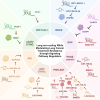Comprehensive review of LncRNA-mediated therapeutic resistance in non-small cell lung cancer
- PMID: 39522033
- PMCID: PMC11549762
- DOI: 10.1186/s12935-024-03549-1
Comprehensive review of LncRNA-mediated therapeutic resistance in non-small cell lung cancer
Abstract
Long non-coding RNAs (lncRNAs) are emerging as crucial regulators of gene expression through diverse mechanisms, including regulation of protein localization, sequestration of miRNAs, recruitment of chromatin modifiers, and modulation of signaling pathways. Accumulating evidence highlights their pivotal roles in tumor initiation, progression, and the development of therapeutic resistance. In this review, we comprehensively summarized the existing literature to identify lncRNAs associated with treatment responses in non-small cell lung cancer (NSCLC). Specifically, we categorized these lncRNAs based on their mechanisms of action in mediating resistance to chemotherapy, targeted therapy, and radiotherapy. Our analysis revealed that aberrant expression of various lncRNAs contributes to the development, metastasis, and therapeutic resistance in NSCLC, ultimately leading to poor clinical outcomes. By elucidating the intricate mechanisms through which lncRNAs modulate therapeutic responses, this review aims to provide mechanistic insights into the heterogeneous treatment outcomes observed in NSCLC patients and unveil potential therapeutic targets for overcoming drug resistance.
Keywords: Chemotherapy; Long non-coding RNA; Non-small cell lung cancer; Radio therapy; Targeted therapy.
© 2024. The Author(s).
Conflict of interest statement
The authors declare no competing interests.
Figures






Similar articles
-
Long noncoding RNAs: new insights into non-small cell lung cancer biology, diagnosis and therapy.Med Oncol. 2016 Feb;33(2):18. doi: 10.1007/s12032-016-0731-2. Epub 2016 Jan 19. Med Oncol. 2016. PMID: 26786153 Review.
-
The functional role of long non-coding RNAs and their underlying mechanisms in drug resistance of non-small cell lung cancer.Life Sci. 2020 Nov 15;261:118362. doi: 10.1016/j.lfs.2020.118362. Epub 2020 Aug 29. Life Sci. 2020. PMID: 32871184 Review.
-
Biological Function of Long Non-coding RNA (LncRNA) Xist.Front Cell Dev Biol. 2021 Jun 10;9:645647. doi: 10.3389/fcell.2021.645647. eCollection 2021. Front Cell Dev Biol. 2021. PMID: 34178980 Free PMC article. Review.
-
Long non-coding RNAs (lncRNAs) signaling in cancer chemoresistance: From prediction to druggability.Drug Resist Updat. 2022 Dec;65:100866. doi: 10.1016/j.drup.2022.100866. Epub 2022 Sep 20. Drug Resist Updat. 2022. PMID: 36198236 Review.
-
Decoding LncRNA in COPD: Unveiling Prognostic and Diagnostic Power and Their Driving Role in Lung Cancer Progression.Int J Mol Sci. 2024 Aug 19;25(16):9001. doi: 10.3390/ijms25169001. Int J Mol Sci. 2024. PMID: 39201688 Free PMC article. Review.
Cited by
-
GAS5 rs145204276 Ins/Del Polymorphism Is Associated with CRC Susceptibility in a Romanian Population.Int J Mol Sci. 2025 Mar 27;26(7):3078. doi: 10.3390/ijms26073078. Int J Mol Sci. 2025. PMID: 40243746 Free PMC article.
-
Top 100 most-cited articles on apoptosis of non-small cell lung cancer over the past two decades: a bibliometrics analysis.Front Immunol. 2025 Jan 13;15:1512349. doi: 10.3389/fimmu.2024.1512349. eCollection 2024. Front Immunol. 2025. PMID: 39872524 Free PMC article.
-
The potential of targeting autophagy-related non-coding RNAs in the treatment of lung cancer.Front Pharmacol. 2025 May 14;16:1551258. doi: 10.3389/fphar.2025.1551258. eCollection 2025. Front Pharmacol. 2025. PMID: 40438586 Free PMC article. Review.
-
LncPTEN1, a long non-coding RNA generated from PTEN, suppresses lung cancer metastasis through the regulation of EMT progress.Noncoding RNA Res. 2025 May 24;14:25-37. doi: 10.1016/j.ncrna.2025.05.011. eCollection 2025 Oct. Noncoding RNA Res. 2025. PMID: 40521243 Free PMC article.
References
-
- Siegel RL, Miller KD, Wagle NS, Jemal A, Cancer statistics. 2023. CA: a cancer journal for clinicians. 2023;73(1):17–48. - PubMed
-
- Siegel RL, Giaquinto AN, Jemal A. Cancer statistics, 2024. Cancer J Clin. 2024;74(1):12–49. - PubMed
-
- Siegel RL, Miller KD, Fuchs HE, Jemal A. Cancer statistics, 2021. Cancer J Clin. 2021;71(1):7–33. - PubMed
Publication types
Grants and funding
LinkOut - more resources
Full Text Sources

